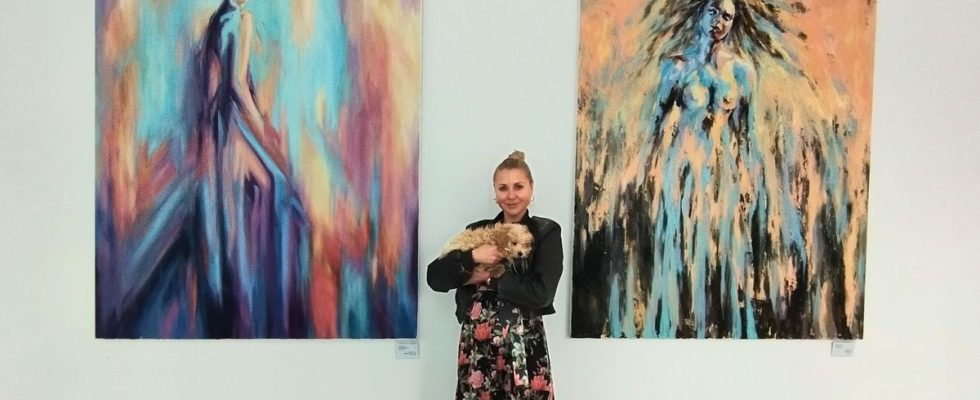Her bichon in one arm, Alina Kosenko opens the glass door of the gallery that bears her name. The smiling young woman opened this structure in Boutcha, in the suburbs of kyiv, a year and a half ago. Six months to the day before the Russian invasion. “I let go of all the staff on February 26 [2022]. When I returned home on the 28th, I came across destroyed armored vehicles and I decided to flee,” she recalls. The painter then took refuge in Lithuania thanks to an evacuation corridor. Leaving behind her freshly opened gallery and all the works it housed.
“In the beginning, in Lithuania, I didn’t know what to do. Why live when everything I had created, everything I had built was in danger of being completely destroyed? “, she remembers. “In times of war, some artists are galvanized while others are in a state of shock, bewilderment,” says historian Fabrice d’Almeida. A shock that crossed Victoria Vladimirska, a young painter who exhibits in the Kosenko gallery. “The first three months, I wondered a lot about the importance of art in the face of the atrocities of war,” she confides. Especially since the artists’ living conditions were turned upside down by the war.
Drink water or paint with it
“The first days under occupation, I painted Unbreakable in the basement of the gallery but there were water cuts. I had to choose between drinking and using water to paint,” says Alina Kosenko. “The daily life of artists sometimes becomes extremely difficult in times of war”, abounds Fabrice d’Almeida. “Among the artists of the Second World War, some could not work because of the cold. How to hold a brush when your fingers are paralyzed by the gel? “, underlines the historian. Alina Kosenko left the painting “unfinished” while fleeing Ukraine. “I thought it wasn’t finished but, after some thought, I decided to leave it with that blank stare. They are the eyes of lost dreams, of destroyed projects”, considers the artist. She made a series on women that she called “Rebellious” to pay tribute to women who volunteer as doctors and to all mothers.

Profits from the sale of these paintings go to the Ukrainian army. Victoria Vladimirska also ended up overcoming the shock of the war. “When I accepted the war, I felt the need to show,” explains the painter who created a series of black and white works, some of which show her premonition before the war. “During these three months when I did not touch a brush, my emotions accumulated. To transcribe is our mission as a painter,” says the young woman. “In Ukraine, we observe the continuation of the heroic dimension of war paint and the use of art as a tool of mobilization, a practice that was born from the years 1920-1930”, analyzes Fabrice d’Almeida .
“Show what’s going on here”
“Artists are witnesses. Practically since the birth of art, they have been asked to document images of war, notes Fabrice d’Almeida. Painting is traditionally associated with war. In Florence, you can see the great battles immortalized by Renaissance painters. But we could go back even further with the great frescoes of Babylon. Since antiquity, we have had artists in the armies. In Ukraine, the government does not pay a painter or a musician to relax the soldiers or to immortalize the horror of war with pigments. But many creators go to the front on their own. “75% of cultural workers have remained in the country despite the war,” said Oleksandr Tkachenko, Minister of Culture.
These creators feel concerned and, often, upset by the war. After her three-month break, Victoria Vladimirska painted on Mariupol, affected by the brutal destruction of this port city where many Ukrainian soldiers held the Azovstal factory under siege, becoming symbols of Ukrainian courage. While painting a completely devastated building, the painter explains that she “had a burning aftertaste in her throat”. Retranscribing courage, suffering, horror through art, this is the objective of the exhibitions of the Kosenko gallery while allowing “to encourage and relax people” details its gallery owner. During the occupation, the structure had been looted of its sound system and digital devices. The windows had been smashed. It has now rebuilt and adapted. “The content of our exhibitions has changed,” admits Alina Kosenko. On August 24, the 32nd anniversary of the country’s independence, the gallery will present an exhibition entitled “Stop war”. To “continue to show what is happening at home”.

